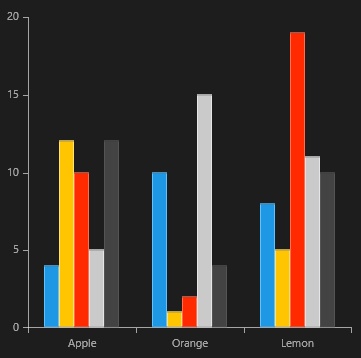How to Generate a Dynamic Series Using a Collection of Collections
The following example demonstrates how to create a RadCartesianChart with a dynamic BarSeries.

-
First, create a class for the sample data.
public class Data { public double Value { get; set; } public string Category { get; set; } } -
Then create the sample data.
List<List<Data>> collection = new List<List<Data>>(); Random r = new Random(); for (int i = 0; i < 5; i++) { List<Data> data = new List<Data>(); data.Add(new Data { Category = "Apple", Value = r.Next(1, 20) }); data.Add(new Data { Category = "Orange", Value = r.Next(1, 20) }); data.Add(new Data { Category = "Lemon", Value = r.Next(1, 20) }); collection.Add(data); } provider.Source = collection; -
Finally, create the chart using XAML.
<telerikChart:RadCartesianChart PaletteName="DefaultDark" > <telerikChart:RadCartesianChart.HorizontalAxis> <telerikChart:CategoricalAxis/> </telerikChart:RadCartesianChart.HorizontalAxis> <telerikChart:RadCartesianChart.VerticalAxis> <telerikChart:LinearAxis/> </telerikChart:RadCartesianChart.VerticalAxis> <telerikChart:RadCartesianChart.SeriesProvider > <telerikChart:ChartSeriesProvider x:Name="provider" > <telerikChart:ChartSeriesProvider.SeriesDescriptors> <telerikChart:CategoricalSeriesDescriptor ValuePath="Value" CategoryPath="Category"> <telerikChart:CategoricalSeriesDescriptor.Style> <Style TargetType="telerikChart:BarSeries"> <Setter Property="CombineMode" Value="Cluster"/> </Style> </telerikChart:CategoricalSeriesDescriptor.Style> </telerikChart:CategoricalSeriesDescriptor> </telerikChart:ChartSeriesProvider.SeriesDescriptors> </telerikChart:ChartSeriesProvider> </telerikChart:RadCartesianChart.SeriesProvider> </telerikChart:RadCartesianChart>